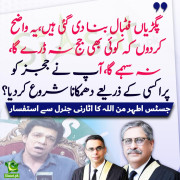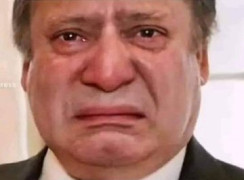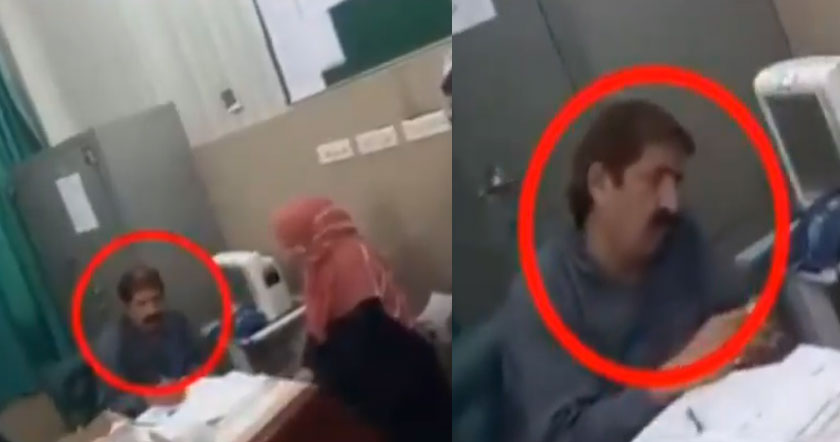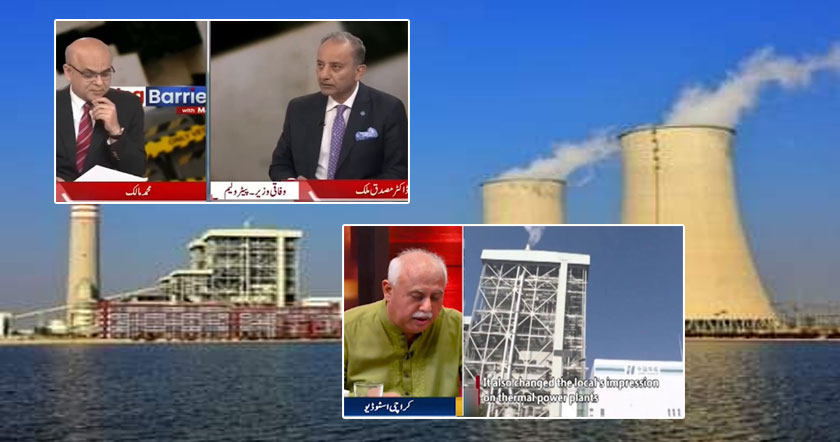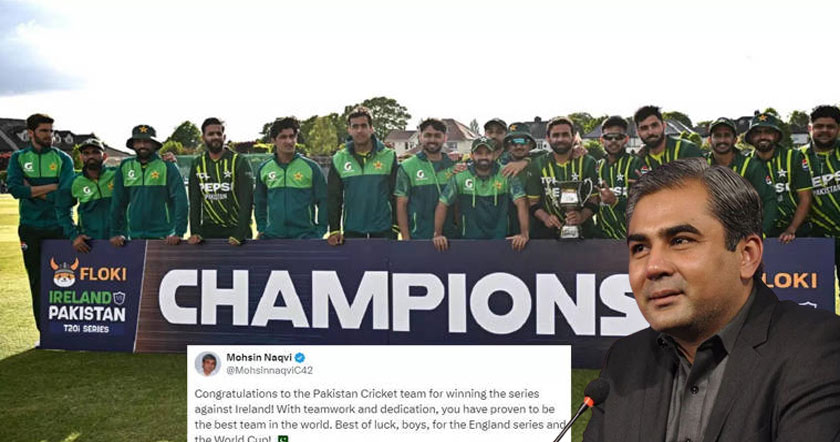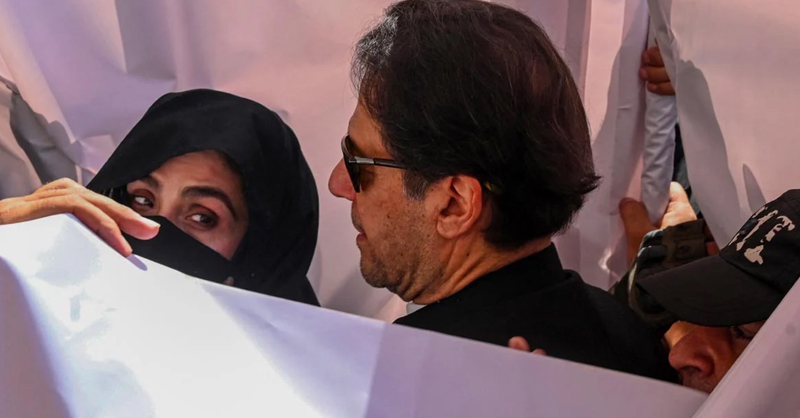The House of Ittefaq
Ittefaq means unity and it was an appropriate name when Mian Mohammad Sharif, father of Prime Minister Nawaz Sharif and his six brothers founded Ittefaq foundry in 1939. The House of Ittefaq, the industrial conglomerate of Prime Minister Nawaz Sharif's family is not unity anymore and 119 offspring's siblings and spouses of the seven founding brothers are currently battling in courts for the division of the assets of the Ittefaq group.
The House of Ittefaq claims to have lost an industrial unit in East Pakistan, besides losing Ittefaq foundry to Bhutto;s nationalization. In the aftermath of nationalization Mian Mohammad Sharif tried luck in UAE where he set up a steel re-rolling mills. He is reported to have told his family that while leaving for UAE that he would not return till the mill was ready. The factory was therefore, completed on time but proved too taxing for aging Mian Sharif in an unfamiliar enviroment and therefore, he returned after operating it for about a year or two.
Lady luck smiled on the Sharif family when in late 1970's General Zia ul Haq returned them Ittefaq foundry and Nawaz Sharif was appointed finance minister in the Punjab cabinet. By that time the House of Ittefaq comprised of following five enterprises.
- Ittefaq Textile
- Nawaz Shahbaz Enterprise
- Jawaid-Pervaiz Enterprise
- Ittefaq Brothers (Pvt) Ltd
- Khalid Siraj Industries (Pvt) Ltd
During first Benazir govt when Nawaz Sharif was the uncrowned King of the powerful Punjab province, the group started work on Brothers Sugar Mills and Ramzan Sugar Mills which turned out to be the last project set up under the banner of Ittefaq. As soon as Nawaz Sharif became Prime Minister in 1990, Mian Mohammad Sharif switched over to setting up projects independent of the other partners, thus laying the grounds for split.
It was said that when Nawaz Sharif became prime minister, the group took a decision to secure project loans from the foreign banks and only working capital was taken from the nationalized commercial banks. The project financing from foreign banks was ostensibly secured against the foreing currency deposits, a number of which were held in benamee accounts, as repeatedly claimed by Interior Minister Naseer Ullah Babar at his press conferences.
At a press conference in Islamabad, on August 3, 1989 Shahbaz Sharif was gave the assets of the group at Rs 3.6 billion, but the report of the Cooperative Scam Tribunal estimated the group assets in 1989, according to their own declaration at Rs 6 billion.
In 1992 when Salman Taseer, Information Secretary, PPP released an account of Nawaz govt's corruption in a booklet "The Plunder of Pakistan" a spokesman of House of Ittefaq said in a counter statement that the group has incurred loans worth Rs 4,420 million only from the commercial banks contrary to Salman Taseer 's claim of Rs 12 billion. According to the spokesman, the group comprised of only 14 companies in its fold with assets of 6 billion.
H U Beg Committee, set up by Nawaz govt in 1990 to investigate the allegations of concentration of wealth had identified 19 companies in the House of Ittefaq with assets worth Rs 10 billion and for the purpose of ranking in this book. I have relied on the estimates of the H U Beg Committee. However at a press conference in Islamabad, on March 2, 1994, Khalid Siraj, a cousin of prime minister claimed that the assets of the seven brothers were valued at Rs 21 billion.
The units in Ittefaq as identified by H U Beg Committee included three listed companies, 12 unlisted public companies and 4 private limited companies.
The Friday Time issue of April 25, 1997 reported that the Sharif group of Mian Mohammad Sharif has started work on Kashmir Sugar Mills and Bashir Sugar Mills for which it was seeking hefty loans from commercial banks. Work is also in progress over a sprawling New Sharif Medical City, opposite the big residential farm of the Sharif family on the Rai Wind Road. The group is also working on Yousaf Aziz Sugar Mills at Kasur and another at Shah Kot.
According to agreement reached in Lahore High Court by members of the family sometimes in 1996, the House of Ittefaq has split in two groups. The first comprised of the families of Mian Mohammad Sharif, Mohammad Shafi, Barkat Ali, Yousaf Aziz and Idrees Bashir while the second group comprised of the families of Meraj Din and Siraj Din. Members of the Ittefaq group are currently operating in three groups namely Sharif Group, Ittefaq Group and Haseeb Waqas Group. The three groups have only four companies listed on the KSE.
Listed companies
1 Ittefaq Textile Mills
2 Brothers Textile Mills
3 Khalid Siraj Textile Mills
4 Haseeb Waqas Sugar
Sharif Group
- Ittefaq Textile
- Mehran Ramzan Textile
- Brothers Textile Mills
- Ramzan Baksh Textile Mills
- Mohammad Baksh Textile Mills
- Hamza Spinning Mills
- Ittefaq Sugar Mills
- Ramzan Sugar Mills
- Chaudri Sugar Mills
- Ittefaq Foundry (Pvt) Ltd
- Brothers Steel Mills
- Ittefaq Brothers (Pvt) Ltd
- Ilyas Enterprise
- Hudaibiya Paper Mills
- Hamza Board Mills
- Hudabia Engineering
- Khalid Siraj Industries
- Ali Haroon Textile Mills
- Hanif Siraj Textile Mills
- Farooq Barkat (Pvt) Ltd
- Abdul Aziz Textile Mills
- Barkat Textile Mills
- Sandalbar Textile Mills
- Haseeb Waqas Rice Mills
- Sardar Board and Paper Mills
- Model Trading House (Pvt) Ltd
- Haseeb Waqas Group
- Haseeb Waqas Sugar Mills
- Haseeb Waqas Engineering
- Haseeb Waqas Farms Ltd
- Haseeb Waqas Rice Mills Ltd
Pakistan's top defaulters:
According to the Moeen Qureshi list of 1993, Fazalsons group was defaulting in the payment of 34 loans amounting to Rs 2,164 million, Hyesons was defaulting in Rs 1,174 million, Habib group in payment of 32 loans worth Rs 850 million, an obscure Naqvi group was in default of Rs 676 million, Tawakkal Rs 479 million, Adamjee Rs 198 million, Dadabhoy Rs 191 million, Hashwani Rs 48.7 million and Fancy Rs 40.6 million.
Major defaulters among the politicians were Chaudharies of Gujrat who were defaulting in payment of six loans worth Rs 109.66 million against Phalia Sugar, Punjab Sugar and Sapco Limited, Ittefaq group Rs 83 million against Ittefaq Foundry, Saifullah's Rs 37.3 million while Zardari group was in default of Rs 7 million.
List of top loan defaulters by Benazir 6.9.1996.
S.No Name Amount Borrowed Default (Rs in Millions)
1 Ittefaq 3,675 2,891
2 Fazalsons 3,475 3,475
3 Tawakkal 1,768 1,464
4 Bela Chemicals 1,259 1,217
5 Abdul Shakoor Kalodia 1,215 1,215
6 Naqvi 1,213 1,060
7 Zahur 1,035 905
8 Ghani 1,023 985
9 Arabian Sea Enterprise 950 913
10 Hyesons 750 725
11 Chaudri Cables 716 684
12 Farooq A Sheikh 632 632
13 Habib 615 615
14 Bawany-Alnoor 601 485
15 Chaudry Shujaat 544 381
16 Dawood 540 325
17 Adamjee 526 494
Total 20,537 18,466
Top defaulters by Meraj Khalid in January 1997
S.No Name Amount in Default (Rs. in Million)
1 Ittefaq 3,013
2 Tawakkal 2,956
3 Fazalsons 2,800
4 Bela Chemicals 2,339
5 Chaudri Shujaat 1,557
6 Abdul Shakoor Koladia 1,254
7 Fauzi Ali Kazim 1,159
8 Saigol 1,086
9 Naqvi 1,056
10 Zahur 1,028
11 Abdullah Al-Rajaih 1,031
12 Ghani 903
13 Habib 845
14 Adamjee 832
15 Hashwani 640
16 Arabian Sea Enterprise 626
17 Sargodha 581
18 United 501
19 Chakwal 441
20 Dawood 376
21 Bawany-Alnoor 352
22 Fateh 213
23 Packages 166
24 Colony 81
Total 25,389
Top four defaulters are common in lists published by Benazir and Meraj Khalid adn 24 individuals and families are defaulting in the payments of Rs 26.7 billion to the nationalized commercial banks and financial institutions. Mian Aftab Ahmad of Fazalsons and Habib Bank Gujranwala merit a special place in the history of banking frauds in Pakistan.
Some Interesting cases of CBR
The Case of Chunian Industrial Estate:
Chunian was declared an industrial estate in 1987 through SRO 400 (10/87) when Mohammad Khan Junejo was Prime Minister, Dr Mahboob ul Haq was finance minister and Nawaz Sharif was the Chief Mininster of Punjab. The SRO was issued on June 17, 1987 but it gave Chunian the retrospective benefit of SRO (500/1/84) under which industries set up in industrial estates were given specific tax holidays. It was not coincidence that House of Ittefaq was operating five industrial units in the Chunian Industrial Estate.
According to the notification issued by the Punjab govt the estate was to be developed on 60,466 acres of land, of which 55,000 acres was private and balance was State land. In a departure from the established pattern it was decided that govt will provide infrastructure and other facilities in the industrial estate but the industrialists will be required to procure land directly from the land owners in the area. According to the various press conferences by Salman Taseer, then Information Secretary PPP and other opposition leaders at least 10% of the land in Chunian Industrial Estate had been bought by the members of Sharif family prior to its declaration as an industrial estate.
In September 1989, Bhutto govt rescinded SRO/1/84 with retrospctive effect from Chunian Industrial Estate meaning thereby that industries set up in the area after 1984, were no longer exempted from payment of income tax and other tax concessions. CBR issued the new SRO as spinelessly and without any rigor of conscience as the one that had provided exemptions with retrospective effect.
The case of import duties on Steel:
The see-sawing of import duties on Steel by Benazir and Nawaz govts also show how unscrupulously the two employed to line personal pockets or tried to kill the bird that was laying the golden eggs for the other.
The federal budget for 1986-87 annouced by Finanace Minister Dr Mahboob ul Haq reduced the flat duty on imported Steel from Rs 750 per tonn to Rs 418 per tonn, yielding net savings of Rs 200 million to Ittefaq Foundary but hardly hit ship breaking industry for which the rate of duty remained at previous level.
However, July 1988-89 budget was announced by the PPP govt which imposed a uniform rate of duty on ship plates and ingots but doubled the rate of duty for billets used by Ittefaq Foundary, causing an annual loss of Rs 580 million to Ittefaq.
In 1991-92 with Nawaz Sharif as Prime Minister, CBR issued SRO 584/91 reducing the custom duty on shredded and bundled scrap from Rs 1,500 to Rs 500 but the custom duty on ship breaking was reduced from Rs 1500 per tonn to Rs 1000 only. This difference in custom duty inflicted death blow to the ship breaking industry but yeilded Rs 1,024 million to Ittefaq Foundary, according to Zahid Sarfraz, Chairman, Accountibilty Committee when Nawaz Sharif govt was dismissed in April 1993 who also claimed that the said SRO was issued without any lawful authority.
In this battle of SROs, ship breaking industry fell victim to Nawaz govt policies to benefit Ittefaq Foundary and subsequently efforts was made by PPP govt to close down the Ittefaq Foundary. In both cases CBR was used by them to issue SRO;s for personal ends and settling personal scores.
The Case of Indus Toyota Motors, The tug of war between Bhutto and Nawaz:
The Indus Toyota project is a clear case of politicking between two main political parties and their govts but for reasons known only to a few, both are reluctant to talk about the real bone of contention.
The Indus Toyota project sponsored by the Habib group was sanctioned by Benazir govt in 1988. It was meant to start progressive manufacture of Toyota Car in Pakistan but immediate effect of the sanction of the project was transfer of franchise for import of Toyota from State owned Pakistan Automobile Corporation (PACO) to the house of Habib yeilding them the windfall revenue of 500 dollars for every Toyota imported into Pakistan.
Before nationalization the Toyota franchise was held by Monnoos and obviously this was a big coupe managed by Habib since several other leading groups including the House of Ittefaq were flexing their muscles to enter the auto industry. But within months of coming into power in 1990, Nawaz govt cancelled the license of Indus Motors Project and demanded of the Toyota Motor Company of Japan to restore the franchise to PACO which had lost the main source of revenue. The matter was resolved only after the intervention of Japanese Embessy and the visit of a delegation of Toyota Company from Japan.
Apparetly the matter has been resolved. But in the 1993-94 budget, govt drastically reduced the import duty on completely built up (CBU) cars, thereby completely upsetting the feasibility of Toyota plant. Fortunately for Habib, Nawaz Sharif resigned in August 1993 and general elections brought Benazir in power.
On January 12, 1994, within two months of coming into power, PPP govt banned the import of reconditioned cars and drastically reduced the import duty on Completely Knocked Down (CKD) kits for cars, thus accruing windfall gains of billions of rupees to Indus Toyota Motor which was the only private sector car assembly plant nearing completion at that time.
During first Sharif govt, PPP leaders were always accusing the govt of victimising the House of Habib but with Benazir in power it was a turn of Muslim League to accuse the govt unduly favouring the Habibs.
A " chronicle of failure, the PPP govt " released by Sartaj Aziz, on January 2, 1994 observed that " the decision of Economic Committee of the Cabinet on January 23, 1994 reducing duty by 30% on CKD and restricting import of reconditioned cars is meant to give tremendous benefits to certain local assemblers of a particular brand whose owner is personal friend of Asif Zardari. This decision is based on personal consideration and will adversely affect the local industry".
While condemning each other over their treatment of the Indus Toyota Project, the leaders of both PPP and PML were shy to fully talk about reasons for which one was allegedly supporting and other was opposing a project of national importance, launched by one of largest industrial groups in the country. A former cabinet minister speaking on condition of anonymity traced the origin of the dispute to a bid by the house of Habib to offer a donation of Rs 10 million to PML govt of Mohammad Khan Junejo. The offer was refused. The minister reported the matter to President Zia ul Haq leading to an official inquiry. Obviously offer of a similar donation was made to the other party which was accepted. Even thieves have a code of honour and so have out polliticians.
The Politics of tax holidays:
A week before Prime Minister Benazir Bhutto was to visit Japan in January 1996, the Ministry of Finance withdrew the fiscal package for Special Industrial Zones (SIZ) that was announced by the PPP govt with great fanfare in January 1994, within weeks of coming into power.
Pakistan had worked hectically for the coveted visit to Japan where Prime Minister was to inaugurate an investors conferences arranged by the Board of Investment. The withdrawal of the package for SIZ was a major embarrassment for the visit, particularly because the publicity matter relating to investment opportunities in Pakistan printed in Japanese language had already been dispatched and contained references to SIZ, as jewel of the crown of the govt economic policies. It was V A Jaffery, the Economic Advisor to Prime Minister who had accepted the IMF demand for withdrawal of the fiscal package for SIZ but Prime Minister House came to know about the withdrawal of the package only when it wanted to issue a contradiction to reports in the newspapers.
Mohib ullah Shah, Secretary, Board of Investment told reporters at several press conferences that he was holding protracted negotiations with IMF delegations, seeking restoration of the concessions. A question that remained unanswered at his press conferences was why IMF had demanded the abolition of the SIZ scheme. At a loss to answer the question, he contented that " SIZ's will generate economic development and employment at the cost of tax collection". He was unaware of the fact that Pakistani entrepreneurs have enjoyed such exemptions and holidays since 1950's. A chronology of tax-exemptions granted by successive govts to encourage industrial investment will prove it.
The 1959 budget announced a two years tax holiday for industries set up anywhere in Pakistan which was extended to four, six and eight years i.e upto 1967 but the exemption for Karachi was allowed to expire after four years.
First budget by Zia ul Haq in 1978 provided a 5-years tax holiday for industries set up between March 1, 1977-June 1983 in Baluchistan, certain parts of NWFP and approved industrial estates in NWFP, Punjab and Sindh.
1983-84 budget extended " all these facilities for another period of five years" i.e up to June 1988. In 1988 Benazir came to power and she announced exemption to all industries set up in the rural areas.
In 1990 Nawaz Sharif came into power and " all industries set up throughout Pakistan between December 1990 and June 30, 1995 were given tax holiday for three years". He also announced a tax holiday of 8 years for all industries proposed to be located in NWFP, Baluchistan (Except Hub), Federally Administered tribal areas (FATA), Azad Kashmir, Division of Dera Ghazi Khan and Bahawalpur in Punjab and Sakkur and Larkana in Sindh, between December 1, 1990-June 1995.
Thus tax holidays that was first introduced for two years in 1959 has lasted for 26 years. The number of industrial estates enjoying tax holidays and exemptions already numbered 44 and the concept of SIZ was simply another effort of keeping the industrialists hooked on exemptions. It was old wine in new bottles.
The rabate, duties bonanza:
The misuse of rebates and duty drawback scheme has emerged as one of the most frequent and remunerative white collar crime in Pakistan during recent years as is evident from the proliferation of stories in newspapers about frauds involving customs officials, exporters and business houses. This facility has also been exploited by political heavy weights with immunity to reap large windfall gains simply by getting the right SRO issued by CBR.
" The system of duty drawbask on exported goods is thoroughly corrupt" under which govt ends up paying more than the amount of taxes collected. Tariq Saigol observed in an interview with Friday Times issue of April 6, 1995.
No consolidated account is available of the rebates and refunds made annually by the CBR in the CBR year book, Economic Survey or any other budgetary publication and the figures of revenue collection periodically released by CBR give only an estimate of net revenue receipts. Gross revenue receipts are never mentioned. An estimated 10-12% of the annual gross tax receipts are currently being refunded by the CBR by way of duty drawbacks and rebates to the exporters and manufacturers. The figure is expected to go up astronomically in 1998, since second Nawaz Sharif govt has increased the use of duty drawbacks as a measure to boost exports. The trade policy for 1997-98 has envisaged host of incentives for boosting export of engineering goods and it provided that " the duty drawback rate of engineering industry will include all inputs including fuel oil". It is not difficult from the ambiguity and enormity of the provision to guess, for the benefit of which engineering industries this policy decision has been taken.
Duty drawbacks and rebates are refunds of the duties and taxes paid by the manufacturers on duty-paid imported raw material used in the value added exports. When the scheme was introduced in the late 1980, it was limited to refunds of import duty, sales tax and presumptive income tax but with a proliferation of taxes, its coverage has been expanded to include all the taxes and incidences paid by exporters including exporters including the municipality taxes. The Collector of Customs, Collector of Sales tax, Income tax directorate, Sea Due Department make refund of billion of rupees every year which are not reflected in the gross revenue receipts.
Rebates are permissible at different rates for different items, under such a complex system that a small favour by the taxation officials can mean a difference of millions of rupees. Two of Pakistan's notorious business groups, the Tawakkal and Schon grew around the export houses known to be claiming rebates based on fake exports, made through letters of credit opened with banks that existed only on papers in South Africa and Cyprus.
The CBR officials told the National Assembly Standing Committee on Finance and Economic Affairs in January 1998 that one of the main reasons for a shortfall in the revenue projections for the fiscal year 1997-98 was the proliferation of SROs that were issued by the CBR for the benefit of individuals and groups. A number of these SRO's have been issued for the benefit of individual industrial units by name, entitling them to rebates with retrospective effect. For example, a notification issued by CBR in July 1997 mentioned Nayyar Industries (Pvt) Ltd, Gujrat and Lahore, owned by relatives of Interior Minister Chaudry Shujaat Hussain to be entitled to refund with retrospective effect, at the rate of 16.9% and 9.4% of FOB prices, respectively, for custom duties and sales tax.
In 1986 when Pakistan was facing acute shortage of sugar, Dr Mahboob ul Haq announced rebates in payment of excise duty to sugar manufacturers, under which sugar mills were entitled to claim rebate of 50% of excise duty on sugar produced in excess of average of last three years. The decision was meant to encourage domestic production and discourage imports but payment of rebate has continued even during years of surplus production.
Nawaz Sharif's House of Ittefaq was a major beneficiary of the decision to pay rebate on sugar in 1986 and PPP leaders claimed at the press conferences that Ittefaq group benefitted to the tune of Rs 500 million, by the decision. Again in 1997 when Nawaz Sharif came into power, one of the several moves by Ittefaq group was seeking payment of arrears of rebates which were allegedly not paid by Benazir Govt.
The duty drawback scheme and the manner in which these rebates are sanctioned is self-explnatory about the in-built provisions for corruption. For example, consider the following examples.
One hundred percent man-made fibres yarn and blended yarn (65% man-made and 35% cotton fibre) are both entitled to refund at Rs 6.75 per KG. However 50 percent blended yarn (50% man-made and 50% cotton) is entitled to rebate at Rs 3.33 per KG, with the result that a small favour by the custom official could double the amount of rebates paid to exporters.
Order no SI/MIsc/20/95-EXR-dated April 6, 1996 issued by the Collector of Customs Karachi revealed that discretionary powers of the Customs officials and the complex manner in which rebates are worked out. The order said that rebate of central excise duty is admissible on tents and tarpalin at a rate of RS 2.50 per KG, on the net wight of textile matirial but exporters have been claiming rebate of non-textile component of their export consignment also. Exporters were therefore, advised that in future, they shall declare weight of textile and non-textile matirial seperately on the bill of export and with relevant export documents. It asked the processing section to ensure that the wight of textile and non-textile material is declared seperately and that rebate of central excise is paid only on the textile component.
While corruption cases in customs rebate have been freqently reported, very little is known about the drawback of income tax permissible, in respect of income earned from export of 258 locally manufactured items. Of these 220 items enjoy 90% rebate, 35 items 75% and only one item i.e yarn enjoy 25% rebate. An article in daily Dawn elaborated how the facility was grossly misused "by deducting huge amounts of income tax at importation stage and then equally huge refunds were made, after the final tax liability was determined".
In the first week of January 1995, high officials of Export Promotion Bureau and Collectorate of Customs, Lahore were arrested for involvement in the rebate scandal of Atlantic Carpets. According to newspaper reports, the firm claimed to have sent 94 consignments of carpets to Europe and USA in a single day and claimed a rebate of Rs 60 million on the cosignment valued at 17.8 million dollars.
In January 1995, customs collectorate Karachi seized a consignment declared as 6000 dozens of knitted T-shirts of various colors and prints valued at Rs 1.5 million but on inspection the lot was found to be consisting of second hand T-shirts, 100 percent substandard factory rejects and semi-stitched pieces of different garments. The consignment was only meant to file rebate claim.
In the fiscal year 1991-92, Messers Concorod Export House, Quetta and Charly Enterprise, Quetta, in collusion with official of customs department registered export of 48 consignments of art silk cloth through Gwader Port and claimed rebate of Rs 131 million of which 121 million was paid to them. However, subsequently, it was found that no export had taken place at all and the export was faked to claim the rebate. A case was registered against the custom officials and the company which is still pending in court till 1996. 69 textile mills were found guilty of fraud by trying to obtain rebates by mis-declaration of quality and description of goods during January 1990-92.
But the best use or misuse of rebate facility was made by a tobacco company in late 1980s exporting cigarettes to Afghanistan and claiming rebates on sales tax and excise duty. Since duties account for 80% of market price of cigarettes, Finance Ministry found out that one dollar being earned by the company, through fake exports to Afghanistan was costing Rs 54 to Pakistan govt. Hence rebate facility on cigarette export was withdrawn. As soon as the federal govt plugged the misuse of cigarette rebate facility, the same company started importing cigarettes from its sister concern in Malaysia in Afghan transit trade, with the connivance of the custom officials.
Mian Mohammad Mansha and Nawaz Sharif- Privatization of Muslim Commercial Bank
The Master Stroke?
"Investment in the shares of MCB has been one of my biggest business slip ups...........In hindsight, I should have never invested in this bank."
Mian Mohammad Mansha-Interview, daily, The Nation, April 28,1997.
Nawaz Sharif Came into power on November 6,1990, invited bids for the privatization of Muslim Commercial Bank (MCB) on December 15,1990 and announced its privatizaion to successful bidder, Messers Abdullah and others on January 9,1991.
Five bids were received for Muslim Commercail Bank with Tawakkals and Adamjee, being the highest and second highest bidders. Adamjee who formed a joint venture with Yunus Brothers, perhaps the biggest Export Houses in Pakistan, had incorporated Muslim Commercial Bank in 1949. As previous owner, they had the first right of purchase but, third lowest bid by Messers Abdullah and others, a consortium comprising of 12 leading industrialists, mostly from Punjab and headed by Mian Mohammad Mansha, was asked to match the highest bid and declared winner. The consortium which called itself the National Group comprised the following leading industrial groups and families:
1 Mohammad Abdullah Saphire
2 S.M.Muneer Din
3 S.S.Saleem Universal Leather and Footwear
4 Mian Mohammad Mansha Nishat
5 Haji Bashir Ahmad Sitara
6 Tariq Rafi Sadiqsons (United)
7 Mohammad Naseem Shafi Tanneries
8 Mohammad Arshad Arshad Textiles
9 Sheikh Mukhtar Ahmad Ibrahim
10 Saqib Elahi Be Be Jan Pakistan (Pvt) Ltd.
11 Bashir Jan Mohammad F and B Bulk Storage (Pvt) Ltd.
12 Khawaja Mohammad Javed Chakwal
At the press Conference called to announce the sale of MCB to the National Group, Finance Minister Sartaj Aziz said that two highest bids were rejected because the bidders had failed to disclose the source of their income. A press release distributed at the press conference claimed that the committee which scrutinized the five bids was guided by four major considerations namely 1) corporate and financial record of bidders, 2) capability of managing the bank on sound professional basis, 3) dispersal of share-holding to avoid concentration of ownership and control and 4) price offered on " as is where is" basis, without any condition.
Tawakkals filed a case in High Court but withdrew it under pressure from the Finance Ministry. In the subsequent privatization by Nawaz Sharif, Tawakkals succeeded in the privatization of three industrial units in such a dubious manner that Chairman, Privatization Commission came to be known as General Saeed Qadir Tawakkal, to rhyme like Abdul Qadir Tawakkal of Tawakkal group.
For nearly 30 months while Nawaz Sharif was in power, Bhutto and her party leaders ceaselessly attacked the privatization process, particularly privatization of MCB to Mian Mansha and his associates, as an act of favourtism and part of a game plan. Farooq Leghari, Finance Minister in the caretaker govt. of Prime Minister Moeen Qureshi, declared on the floor of the Senate on May 18,1993 that MCB was privatized as part of a grand design to grab some of the most profitable units slated for privatization.
" In the very first case of privatization of MCB, highest bidder who was the oringinal owner was also excluded. The third group got it. And I will tell you later, what happened to the third group and how they manipulated and used MCB for a host of other takeovers of the govt. corporate sector. It did not happen by coincidence. It happened by design", Leghari declared.
But all said and done, the story behind MCB's privatization has not been told and perhaps will never be told because those who could have done it, decided to make real capital after making political capital out of it. Once she came into power in 1993, Benazir developed amnesia about her pledge to investigate the privatization of MCB. However, MCB President Hussain Lawai, accompanied by Mian Mohammad Mansha held at least one meeting with Prime Minister's spouse Asif Zardari. Nobody knows what transpired in the meeting but within a week Mian Mansha went into forced exile, to return to Pakistan only after the ouster of Benazir in Nov 1996. It was also, only after the dissmissal of her govt. that collusion between Lawai and Asif Zardari, in several remunerative deals like award of gold monopoly to ARY Traders, loan to Sadaruddin Hashwani to facilitate the purchase of Occidental Petroleum and dubious UBL privatization to Basharahill became the public knowledge.
During first Benazir govt.(1988-90) Saddaruddin Hashwani had gone into forced exile, after a meeting with Asif Zardari amidst reports that he was under pressure to deliver Pakistan Services Ltd. operating the chain of Pearl Continental Hotels to a nominee of Asif Zardari.
While Mian Mansha was in exile, S M Munir, a member of National Group owning MCB and Chairman, Din group was appointed a federal minister. President MCB, Hussain Lawai was appointed an adviser to the Prime Minister.
" Mian Mansha can not be forgiven", a close aide to Prime Minister Nawaz Sharif, now a cabinet minister told a group of reporters in the National Assembly cafeteria, minutes after the new assembly had taken oath in Feb 1997. Mansha and his associates had wholeheartedly supported first Nawaz govt as is evident from the number of companies incorporated and listed on KSE, by Nishat and Chinioti communitiy. What went wrong between the " Lahore Maphia" and second Nawaz govt is a big mystery? But let us see how MCB was used to raid the State enterprises?
MCB was sold for Rs 2,420 against a down-payment of Rs 804 million. Within a year of privatization of MCB, Privatization Commission sold some of the most profitable cement plants to Mian Mansha, his relatives and business associates. Thus D G Khan Cement was sold to Tariq Saeed Saigol for Rs 1,799 million, Maple Leaf Cement to Nishat Mills for Rs 291 million, Pak Cement and White Cement for Rs 137 million and Rs 188 million respectively to Mian Jehangir Elahi and Associates. Dandot Cement was sold to the Chakwal group for Rs 254 million.
D G Khan Cement was acquired by Kohinoor Textile Mills (KTM) of Tariq Saeed Saigol by borrowing heavily from the bank, as is evident from the annual reports of KTM for 1992 which show no debt and 1993 which reveal heavy indebtedness.
Nishat Mills had assumed the management of Maple Leaf Cement on Jan 8, 1992 but within a few months of the sale D G Khan Cement by KTM to Mian Mansha, Maple Leaf Cement was sold by Mian Mansha to Tariq Saeed Saigol. KTM had also invested in the privatization of White Cement and Pak Cement but its investment was also divested in March 1992, in favour of Mian Mansha.
Dandot Cement was officially privatized to employees group but somehow it has become a part of Chakwal group, also closely related in business to Mian Mansha.
Thus it was through a complex intercorporate financing that Mian Mansha, his relatives and business associates ended up with five of eight privatized cement units which accounted for 45% to total industrial assets privatized by Nawaz Sharif. Within months of their privatization, cement prices catapulated in domestic market, forcing the govt. to order the dormant Monopoly Control Authority (MCA) to hold an inquiry into the possibility of cartelisation of cement. As was expected the inquiry absolved the privatized units of any wrong doing.
It was because of the assets acquired in privatization that Nishat group of Mian Mansha which was at the 15th position among the list of 43 top industrial families in Pakistan in 1972 and sixth in the ranking of the Monthly Herald in 1990 had risen to the top of the corporate world in 1993, by the time, Nawaz Sharif was dismissed on charges of corruption and other irregularities.
Nawaz Sharif and Chiniotis
Few months before Nawaz Sharif came into power in 1990, an article in the monthly, Herald about the 22 families ranked Habib to be number 1, followed by Crescent at 2, Dawood at 3 and Saigols at four. The monthly Herald's list of top 25 families included 9 Punjab based groups of which six were Chiniotis. However three years rule of Nawaz Sharif was to radically transform this balance of economic power between Karachi and Punjab.
Punjab and Chiniotis generally and Mian Mohammad Mansha and his associates particularly proposed during the chief minister-ship of Nawaz Sharif. Pasrur Sugar Mills and Samundri Sugar Mills of Punjab Industrial Development Board (PIDB) were privatized to Monnoos and United group. Within months of coming into power as Prime Minister in 1990, the management of National Development Leasing Corporation (NDLC) was withdrawn from House of Habib and handed over to the United group.
Nearly half of the assets privatized by Nawaz Sharif ended up with Mansha, his relatives or business associates. But bringing together the National group to bid for Muslim Commercial Bank was the biggest business coupe that Chiniotis could have staged against their main business rivals. Before nationalization, Muslim Commercial Bank was a Memon Bank owned by Adamjee and its purchase by Chiniotis demonstrated their rising power and the decline of the Memons. The National group which bought Muslim Commercial Bank was a consortium of 12 leading industrial families, of whom all but two, Chakwal and Bashir Jan Mohammad were not Chinioti. While Muslim Commercial Bank was the flagship of Chiniotis rising power, they called upon a Memon banker Hussain Lawai to head it.
A Nishat group profile in 1990 estimated that its assets were worth Rs 4 billion but the group profile in 1993 placed its assets at Rs 10 billion, a phenominal 250% increase in assets in three years.
Seventy five percent of the newly listed companies during three years of Nawaz Sharif belonged to the Chiniotis. Mansha launched seven new companies and Crescent listed eight new companies at the Karachi Stock Exchange.
Earlier in this book we have reported about the Gas-war between the Memons and the Ismaeeli Khojas (Fancy) over the setting up of the first Non-Memon Textile Mills in Karachi but the resignation with which the Memons allowed Chiniotis to overtake them, in Bhutto and post-Bhutto era is amazing and a loud proclaimation of their disinterest in long-term economic development of Pakistan. While in 1960's every fourth factory in Pakistan belonged to a Memon, the Chiniotis own 125 out of 750 companies listed on the KSE in 1997.
Chiniotis are a close fraternity who seldom marry outside their clan, with the result that marriages have come to play an importent role in their growth and kinship. During his interview with the author, Mian Habib took out a red book from his drawer which contained the names of 80 Chiniotis living in Islamabad and said that in the event of a marriage, a party or a tragedy in a Chinioti family, first people to get the information are the people listed in the book. Every city has its own directory of the Chiniotis.
Chiniotis take pride that they are born businessmen and serve through industry. Unlike Memons who have a Memon Society of Professionals, there are very few prominent Chinioti professionals or civil servants. Mazhar Rafi, former Secretary Defense Production was the most well known Chinioti to succeed outside business and industry and the top military man from Chiniot was one Brigadier Mehboob.
" Chiniotis are born businessmen, born to serve the nation by setting up industaries. They seldom invest in cinema, hotels and activities like gambling prohibited by the religion. They are never suspected of shifting their capital abroad. It is the Chinioti Crescent group which is known as the exemplary tax payer", Habib Ullah pointed out.
Mian Habib Ullah himself is a living exemple of the business acumen of his fraternity. His grandfather Nazar Mohammad had started export of hides and skins from Southern India and set up several industrial units including Zeenat Textile Mills with 25,000 spindles and 500 looms in 1952. It was after his father's death in 1981 that Mian Habib Ullah launched his own independent business, by buying off shares of his uncles in the family enterprise D M Textile Mills. He now heads a small group comprising D M Textile, Omer Textile, Bilal Fibre and Shalimar Textile.
Mian Shaukat Masud is another budding Chinioti businessman from the twin cities of Rawalpindi and Islamabad and is member of a fairly large but unknown Fazal group Industries, with headquarters in Multan. The group has 24 units in its fold including Fazal Cloth, Reliance Weaving, Fatima enterprise, Sh Fazalur-Rehman and Sons and Mubarik Textile listed on KSE. Some unlisted units are Ahmad Fine Spinning Mills, Hussain Mills, Fatima Fazal Soap and Fatima Sugar. The entire production of four textile mills is exclusively devoted to export, mainly to Japan while some members of the family have set up independent units, Shaukat said.
One of the Shaukat's cousins who married an American girl has set up Carolina Textile Mills at Jabal-e-Ali in Middle East.
" Fazal group of Industries or Fatima group was founded by Shaukat's grandfather Mian Fazal-ur-Rehman who was working as a helper on a grocery shop in pre-independence Pakistan. He had to quit his job at the grocery shop when he lost his eyesight and was dropping a lot of bottles incurring loss to shop owner", Shaukat recalled.
The loss of job forced Fazalur-Rehman to go back to family's kitty and pool the resources of family and friends to set up Fazal Edible Oil factory at Multan. The business was expanding when it was hit by nationalization of Edible oil and rice husking units.
Shaukat said he would never forgive Pakistan's Peoples Party for causing the death of his father, Mian Masud who took it upon himself to lead one man crusade against nationalization.
" The days immediately after nationalization were like family history taking full circle back to 1947 when we had to think about the humiliation of finding jobs, he recalled. Sheikh Fazal had nine sons and all the families again pooled their resources and handed it to eldest brother Sheikh Rashid Ahmad to set up Fazal Cloth Mills which became the nucleus for growth of the group to their present position.
Companies owned by Chiniotis on KSE
S. No Name No. of Companies
1 Crescent 21
2 Nishat 13
3 United 9
4 Saphire 8
5 Sargodha 8
6 Colony 6
7 Fazal Sons 5
8 Ibrahim 5
9 Arshad 5
10 Fatima 4
11 Tata 3
12 Nagina 3
13 Jehangir Elahi 4
14 JSK 2
15 Ayesha 2
16 Monnoo 2
17 Mian Habib Ullah 2
18 Sunshine 2
19 Chenab 2
20 Din 1
21 Ali Asghar Textile 1
22 Adamjee Industries 1
23 Nusrat Textile 1
24 Ruby Textile 1
25 Quetta Textile 1
26 Khurshid Spinning 1
27 Diamond Industries 1
Much more on this old site with very interesting info on who owns Pakistan:
http://richpaki.tripod.com/index1.html







